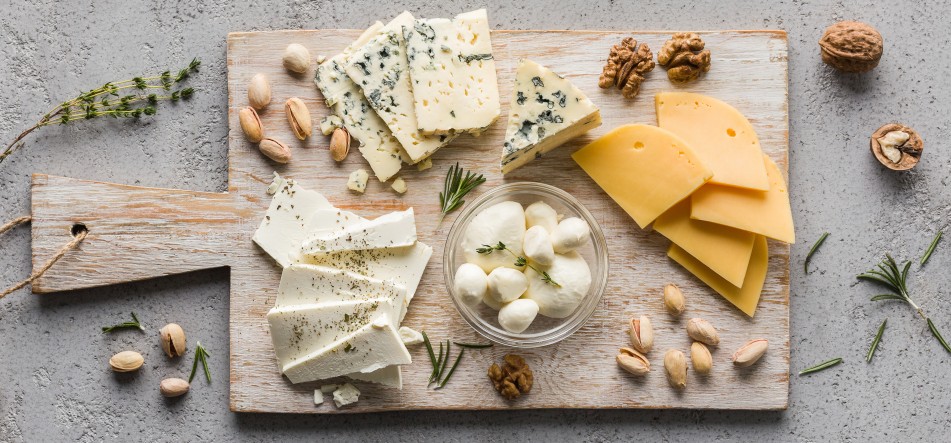
Sweeten Up Your 4th of July With These Patriotic Desserts
June 30, 2023
Posted: June 4, 2022 10:44 am





There is no denying that cheese adds great flavour to our meals. But it is also suitable for you, providing lots of nutrients and health benefits. However, there are so many different cheeses that choosing one can be a challenge.
Ingredients:
Directions:
1. Pour the milk into a large pot and heat it over medium heat until it reaches 90 degrees F, occasionally stirring, so it doesn’t burn. If you don’t have a thermometer, watch for steam to rise from the surface of the milk when you mix it; that means it’s about ready to be heated. Don’t let it get too hot. The best temperature for making mozzarella is between 90 and 100 degrees F.
2. Once your milk has reached its ideal temperature, add the citric acid solution and stir well to combine. Let this sit for 5 minutes—it will curdle into clumps that look like cottage cheese but will still be very thin, inconsistency.
You can make Emmental cheese at home. It’s not as complicated as you think, and it’ll leave your kitchen smelling amazing.
First, you’ll need some pasteurized milk. If you’re lactose intolerant or vegan, you can use soy milk instead of regular milk.
Next, add a starter culture to the milk—this will help it ferment into cheese. You can buy a culture online or at your local health food store. If you aren’t sure what type of starter culture to use, ask a clerk in the store for advice.
After that, add rennet to the milk: this turns the protein in the milk into curds and whey (the good stuff that makes cheese). You can buy rennet at any grocery or health food store; ask for “animal rennet”.
Now that all your ingredients are together bring them to a boil in a non-reactive pot (like stainless steel or enamel). Stir constantly until it reaches 105°F (40°C). Then let it cool down until it reaches 90°F (32°C). Pour this into sanitized moulds and let them sit overnight at room temperature (68–72°F/20–22°C).

Ingredients:
Directions:
1. In a large saucepan, heat the milk to 180 degrees F (but no higher than that). This should take about 30 minutes on medium-low heat. If your stove doesn’t go that low, turn it down as low as it will go and prop the lid open with a wooden spoon or another object so that the steam can escape while still heating the milk.
2. Once the milk is heated, add your salt, pepper, and mustard powder, stirring well to combine. Let this sit for 5 minutes before straining it through a cheesecloth-lined colander into a bowl or pitcher. You can also use a mesh strainer if you don’t have cheesecloth handy.
3. Now you’re ready to enjoy your homemade cheddar. Remember that it’s best stored in an airtight container in the fridge for up to two weeks.
Gouda is a cheese that originates from the Netherlands, and it’s a hard cheese made from cow’s milk.
You can make Gouda at home by following these simple instructions:
1. Heat the milk to 86 degrees Fahrenheit (or 29 degrees Celsius) in a large pot on your stovetop or oven.
2. Add rennet to a small cup of warm water and let it sit for ten minutes before using it to create an enzyme that helps separate the curds from the whey.
3. Once your milk has cooled to approximately 72 degrees Fahrenheit (22 degrees Celsius), add the rennet mixture into it and stir well until it has completely dissolved into the milk.
4. Let your mixture sit for 45 minutes so that the rennet can work its magic on splitting the curds from the whey.
Ingredients:
Directions:
1. Heat the milk to 35°C. Stir in the rennet and let it stand for 30 minutes. To make the cheese even more creamy, add some cream to the milk before adding the rennet.
2. Pour off a little of the whey (the liquid in which the curd is floating), then scoop out enough curds with a slotted spoon to fill a small bowl (about 1/3 cup). The shape doesn’t matter where—they can be round or square or anything else you like—as long as they’re uniform in size, they’ll cook at the same rate. Carefully transfer them back into your pot one by one so as not to break their delicate structure, then repeat this process until you have enough curds to fill your colander with about 2 litres worth (about 1/4 cup each). This may take several batches over several days if you only have one colander; don’t leave them too long before draining them again because they’ll begin to break down into mush.
Feta is a delicious, salty cheese perfect for pairing with fresh vegetables and herbs.
Ingredients:
Directions:
1. Heat your milk in a pot on the stove until it reaches 185°F. Stir constantly, so it doesn’t burn.
2. Turn off heat and let cool for 10 minutes, occasionally stirring to avoid clumping. The milk should now be at 110°F to 115°F. Add in the vinegar and mix thoroughly with a whisk or wooden spoon. Make sure all lumps are gone.
3. Let sit at room temperature for 2 hours, then transfer to an airtight container and refrigerate overnight (or up to 5 days).
Parmesan cheese is a staple in many kitchens, but it can often be expensive. Luckily, making your own is easy and affordable.
Ingredients:
Instructions:
Pour the milk into a large pot. Heat until it reaches 90 degrees Fahrenheit—you’ll know it’s warm enough if you can stick your finger in for about five seconds and feel it’s just slightly warmer than body temperature. Add the vinegar and stir until curds separate from the whey (this should happen pretty quickly). Pour through cheesecloth into a colander lined with paper towels or coffee filters to remove any excess liquid. Place on a plate in the refrigerator overnight to dry out completely before serving.
This recipe for Gruyere, a hard cheese from Switzerland, is one of many’s favourites. It’s a great way to get the kids involved in your cooking, and it’s also a great way to make a treat for yourself.
Ingredients:
Directions:
1. Heat milk on medium-low heat until it reaches 175 degrees Farenheit. You can use an instant-read thermometer or keep an eye on it until it gets close to this temperature. You do not want to boil the milk! If you do, it will curdle, and you’ll have to start over.
2. Add 1/2 cup of vinegar slowly while constantly stirring with a whisk (this will prevent lumps). This should take about 5 minutes total; when all of the vinegar is incorporated into the milk, remove from heat and let cool to 110 degrees Farenheit (this should take about 10 minutes).
3. While waiting for your milk mixture to cool down, mix flour and remaining 1/4 cup of vinegar in a small bowl until smooth; set aside until ready to use.
4. When the mixture has cooled completely (test by sticking your finger into it.
Mascarpone is a soft, creamy cheese that’s used in a variety of different dishes. Here is one of favourite ways to make it at home.
1. Beat together 1 egg and 2 tablespoons of sugar until light and fluffy. Add 4 ounces mascarpone cheese, 1 teaspoon vanilla extract, and 1/2 cup sour cream until well combined.
2. Soften 2 tablespoons butter in the microwave for 30 seconds or until melted. Add 1 cup mascarpone cheese and beat until smooth, then add 1 teaspoon vanilla extract and beat again until fluffy if you want to add zest or other flavours like lemon or orange juice (use about 2 tablespoons).
3. In a small bowl, combine 2 teaspoons cornstarch with 1/4 cup cold water until dissolved, then whisk in 3 ounces mascarpone cheese until smooth. Microwave for 15 seconds at half power, then whisk again until smooth; repeat microwaving for 15 seconds at half power until thickened (about 2 minutes total). You can keep this warm in the microwave for up to an hour before serving.
Brie is a soft, creamy cheese with a mild flavour. It’s typically eaten at room temperature, and it pairs well with fruits and nuts.
Brie can be served as part of an appetizer plate or on its own in a small dish. It can also be melted over other dishes, such as grilled chicken or steak.
To make Brie at home, follow these simple steps:
1. Add 1/2 cup of cream cheese to a bowl and mix until smooth.
2. Add 1/4 teaspoon salt, 2 teaspoons minced garlic, 1 teaspoon dried basil, 1 teaspoon dried oregano, 1 teaspoon dried thyme and 1 teaspoon paprika to the bowl with the cream cheese and mix well until evenly distributed throughout the mixture (about 30 seconds).
3. Spread about four tablespoons of this mixture onto each side of two pieces of French bread (or baguette) until it covers the entire surface area evenly without creating any air pockets between layers underneath it nor too much excess material leftover on top afterwards–and then refrigerate both pieces overnight before serving them up tomorrow morning.
National Cheese Day is a holiday that celebrates all things cheese, from the creamy and delicious to the funky and stinky. It’s a day for all cheese lovers to come together and celebrate their favourite dairy product.
The story of National Cheese Day began in June of 1949 when President Truman signed into law a bill that made it illegal to kill mice on your farm without first obtaining a license from the state. This was just one of many laws passed during this time that sought to protect small farmers from big business interests, becoming more potent throughout America.
In 1951, dairy farmers were struggling under increased regulations. They felt that they were being mistreated by big companies who were buying up their land and paying them less than what they deserved for selling it. So they decided to take action: On June 4th, 1949, they held protests across the country against what they saw as unfair treatment by big corporations. The demonstrations were so successful that Congress passed a new law called “The Milk Price Crop Act”, which allowed dairy farmers to sell their milk at whatever price they chose.
Because of its distinctive taste, cheese remains a popular ingredient in many dishes. From easy recipes to complex dishes requiring a high level of skill in preparation, cheese abounds in popularity and is enjoyed throughout the world.

June 13, 2023

May 10, 2023